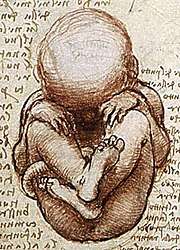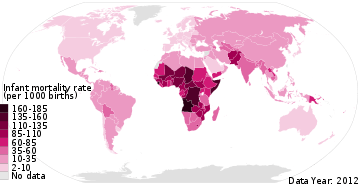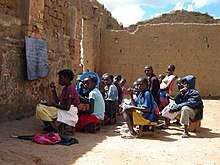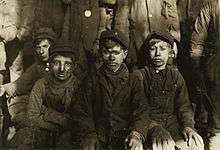Child
Biologically, a child (plural children) is a human being between the stages of birth and puberty,[1][2] or between the developmental period of infancy and puberty.[3] The legal definition of child generally refers to a minor, otherwise known as a person younger than the age of majority.[1] Children generally have fewer rights and less responsibility than adults. They are classed as unable to make serious decisions, and legally must be under the care of their parents or another responsible caregiver.
| Part of a series on |
| Human growth and development |
|---|
 |
| Stages |
| Biological milestones |
| Development and psychology |
|
Child may also describe a relationship with a parent (such as sons and daughters of any age)[4] or, metaphorically, an authority figure, or signify group membership in a clan, tribe, or religion; it can also signify being strongly affected by a specific time, place, or circumstance, as in "a child of nature" or "a child of the Sixties".[5]
Biological, legal and social definitions

Biologically, a child is a person between birth and puberty,[1][2] or between the developmental period of infancy and puberty.[3] Legally, the term child may refer to anyone below the age of majority or some other age limit.
The United Nations Convention on the Rights of the Child defines child as "a human being below the age of 18 years unless under the law applicable to the child, majority is attained earlier".[6] This is ratified by 192 of 194 member countries. The term child may also refer to someone below another legally defined age limit unconnected to the age of majority. In Singapore, for example, a child is legally defined as someone under the age of 14 under the "Children and Young Persons Act" whereas the age of majority is 21.[7][8] In U.S. Immigration Law, a child refers to anyone who is under the age of 21.[9]
Some English definitions of the word child include the fetus (sometimes termed the unborn).[10] In many cultures, a child is considered an adult after undergoing a rite of passage, which may or may not correspond to the time of puberty.
Children generally have fewer rights than adults and are classed as unable to make serious decisions, and legally must always be under the care of a responsible adult or child custody, whether their parents divorce or not. Recognition of childhood as a state different from adulthood began to emerge in the 16th and 17th centuries. Society began to relate to the child not as a miniature adult but as a person of a lower level of maturity needing adult protection, love and nurturing. This change can be traced in paintings: In the Middle Ages, children were portrayed in art as miniature adults with no childlike characteristics. In the 16th century, images of children began to acquire a distinct childlike appearance. From the late 17th century onwards, children were shown playing with toys and later literature for children also began to develop at this time.[11]
Development
According to Professor Peter Jones of Cambridge University development of the brain continues long past legal definitions of adulthood so "to have a definition of when you move from childhood to adulthood looks increasingly absurd. It's a much more nuanced transition that takes place over three decades."[12] Children go through stages of social development. Children learn initially through play and later in most societies through formal schooling. As a child is growing they are learning how to do some tasks in chronological order. They learn how to prioritize their goals and actions. Their behavior is transcending as they learn new perspectives from other people. They learn how to represent certain things symbolically and learn new behavior.[13]
Health
Children with ADHD and learning disabilities may need extra help to develop social skills. The impulsive characteristics of an ADHD child may lead to poor peer relationships. Children with poor attention spans may not tune into social cues in their environment, making it difficult for them to learn social skills through experience.[14] Health issues affecting children are generally managed separately from those affecting adults, by pediatricians.
Age of responsibility
The age at which children are considered responsible for their society-bound actions (e. g. marriage, voting, etc.) has also changed over time, and this is reflected in the way they are treated in courts of law. In Roman times, children were regarded as not culpable for crimes, a position later adopted by the Church. In the 19th century, children younger than seven years old were believed incapable of crime. Children from the age of seven forward were considered responsible for their actions. Therefore, they could face criminal charges, be sent to adult prison, and be punished like adults by whipping, branding or hanging. However, courts at the time would consider the offender's age when deliberating sentencing.[15] Minimum employment age and marriage age also vary. The age limit of voluntary/involuntary military service is also disputed at the international level.[16]
Child mortality

During the early 17th century in England, about two-thirds of all children died before the age of four.[18] During the Industrial Revolution, the life expectancy of children increased dramatically.[19] This has continued in England, and in the 21st century child mortality rates have fallen across the world. About 12.6 million under-five infants died worldwide in 1990, which declined to 6.6 million in 2012. The infant mortality rate dropped from 90 deaths per 1,000 live births in 1990, to 48 in 2012. The highest average infant mortality rates are in sub-Saharan Africa, at 98 deaths per 1,000 live births – over double the world's average.[17]
Education

Education, in the general sense, refers to the act or process of imparting or acquiring general knowledge, developing the powers of reasoning and judgment, and preparing intellectually for mature life.[20] Formal education most often takes place through schooling. A right to education has been recognized by some governments. At the global level, Article 13 of the United Nations' 1966 International Covenant on Economic, Social and Cultural Rights recognizes the right of everyone to an education.[21] Education is compulsory in most places up to a certain age, but attendance at school may not be, with alternative options such as home-schooling or e-learning being recognized as valid forms of education in certain jurisdictions.
Children in some countries (especially in parts of Africa and Asia) are often kept out of school, or attend only for short periods. Data from UNICEF indicate that in 2011, 57 million children were out of school; and more than 20% of African children have never attended primary school or have left without completing primary education.[22] According to a UN report, warfare is preventing 28 million children worldwide from receiving an education, due to the risk of sexual violence and attacks in schools.[23] Other factors that keep children out of school include poverty, child labor, social attitudes, and long distances to school.[24][25]
Attitudes toward children

Social attitudes toward children differ around the world in various cultures and change over time. A 1988 study on European attitudes toward the centrality of children found that Italy was more child-centric and the Netherlands less child-centric, with other countries, such as Austria, Great Britain, Ireland and West Germany falling in between.[26]
In 2013, child marriage rates of female children under the age of 18 reached 75% in Niger, 68% in Central African Republic and Chad, 66% in Bangladesh, and 47% in India.[27] According to a 2019 UNICEF report on child marriage, 37% of females were married before the age of 18 in sub-Saharan Africa, followed by South Asia at 30%. Lower levels were found in Latin America and Caribbean (25%), the Middle East and North Africa (18%), and Eastern Europe and Central Asia (11%), while rates in Western Europe and North America were minimal.[28] Child marriage is more prevalent with girls, but also involves boys. A 2018 study in the journal Vulnerable Children and Youth Studies found that, worldwide, 4.5% of males are married before age 18, with the Central African Republic having the highest average rate at 27.9%.[29]
Protection of children from abuse is considered an important contemporary goal. This includes protecting children from exploitation such as child labor, child trafficking and selling, child sexual abuse, including child prostitution and child pornography, military use of children, and child laundering in illegal adoptions. There exist several international instruments for these purposes, such as:
- Worst Forms of Child Labour Convention
- Minimum Age Convention, 1973
- Optional Protocol on the Sale of Children, Child Prostitution and Child Pornography
- Council of Europe Convention on the Protection of Children against Sexual Exploitation and Sexual Abuse
- Optional Protocol on the Involvement of Children in Armed Conflict
- Hague Adoption Convention
Emergencies and conflicts
Emergencies and conflicts pose detrimental risks to the health, safety, and well-being of children. There are many different kinds of conflicts and emergencies, e.g. wars and natural disasters. As of 2010 approximately 13 million children are displaced by armed conflicts and violence around the world.[30] Where violent conflicts are the norm, the lives of young children are significantly disrupted and their families have great difficulty in offering the sensitive and consistent care that young children need for their healthy development.[30] Studies on the effect of emergencies and conflict on the physical and mental health of children between birth and 8 years old show that where the disaster is natural, the rate of PTSD occurs in anywhere from 3 to 87 percent of affected children.[31] However, rates of PTSD for children living in chronic conflict conditions varies from 15 to 50 percent.[32][33]
See also
Sources
![]()
![]()
References
- "Child". TheFreeDictionary.com. Retrieved 5 January 2013.
- Mosby, Inc (2013). Mosby's Dictionary of Medicine, Nursing & Health Professions. Elsevier Health Sciences. p. 345. ISBN 0323074030.
- Rathus SA (2013). Childhood and Adolescence: Voyages in Development. Cengage Learning. p. 48. ISBN 1285677595.
- "For example, the US Social Security department specifically defines an adult child as being over 18". Ssa.gov. Archived from the original on 1 October 2013. Retrieved 9 October 2013.
- "American Heritage Dictionary". 7 December 2007. Archived from the original on 29 December 2007.
- "Convention on the Rights of the Child" (PDF). The Policy Press, Office of the United Nations High Commissioner for Human Rights. Archived from the original (PDF) on 31 October 2010.
- "Children and Young Persons Act". Singapore Statutes Online. Retrieved 20 October 2017.
- "Proposal to lower the Age of Contractual Capacity from 21 years to 18 years, and the Civil Law (Amendment) Bill". Singapore: Ministry of Law. Archived from the original on 26 June 2018. Retrieved 21 October 2017.
- "8 U.S. Code § 1101 - Definitions". LII / Legal Information Institute.
- See Shorter Oxford English Dictionary 397 (6th ed. 2007), which's first definition is "A fetus; an infant;...". See also ‘The Compact Edition of the Oxford English Dictionary: Complete Text Reproduced Micrographically’, Vol. I (Oxford University Press, Oxford 1971): 396, which defines it as: ‘The unborn or newly born human being; foetus, infant’.
- . "Essays on childhood". Elizabethi.org. Retrieved 9 October 2013.CS1 maint: numeric names: authors list (link)
- "People don't become 'adults' until their 30s, say scientists". BBC. 19 March 2019. Retrieved 20 March 2019.
- "Why Children Need Play | Scholastic". www.scholastic.com. Retrieved 16 November 2017.
- "Socialization stages". Childdevelopmentinfo.com. Archived from the original on 28 March 2014. Retrieved 9 October 2013.
- Fikadu Satena. "Juvenile courts". Law.jrank.org. Retrieved 9 October 2013.
- Yun, Seira (2014). "Breaking Imaginary Barriers: Obligations of Armed Non-State Actors Under General Human Rights Law – The Case of the Optional Protocol to the Convention on the Rights of the Child". Journal of International Humanitarian Legal Studies. 5 (1–2): 213–257. SSRN 2556825.
- Infant Mortality Rates in 2012 Archived 14 July 2014 at the Wayback Machine, UNICEF, 2013.
- W.J. Rorabaugh, Donald T. Critchlow, Paula C. Baker (2004). "America's promise: a concise history of the United States". Rowman & Littlefield. p. 47. ISBN 0-7425-1189-8
- "Modernization - Population Change". Encyclopædia Britannica
- "Education | Define Education at Dictionary.com". Dictionary.reference.com. Retrieved 3 August 2014.
- ICESCR, Article 13.1
- "Out-of-School Children Initiative | Basic education and gender equality". UNICEF. Archived from the original on 6 August 2014. Retrieved 3 August 2014.
- "BBC News - Unesco: Conflict robs 28 million children of education". Bbc.co.uk. 1 March 2011. Retrieved 3 August 2014.
- "UK | Education | Barriers to getting an education". BBC News. 10 April 2006. Retrieved 3 August 2014.
- Melik, James (11 October 2012). "BBC News - Africa gold rush lures children out of school". Bbc.com. Retrieved 3 August 2014.
- "Rachel K. Jones and April Brayfield, Life's greatest joy?: European attitudes toward the centrality of children. Social Forces, Vol. 75, No. 4, Jun 1997. 1,239-69 pp. Chapel Hill, North Carolina". Popindex.princeton.edu. Retrieved 9 October 2013.
- "Child brides around the world sold off like cattle". USA Today. 8 March 2013.
- "Child marriage". UNICEF DATA. Retrieved 27 April 2020.
- Gastón, Colleen Murray; Misunas, Christina; Cappa, Claudia (3 July 2019). "Child marriage among boys: a global overview of available data". Vulnerable Children and Youth Studies. 14 (3): 219–228. doi:10.1080/17450128.2019.1566584. ISSN 1745-0128.
- UNICEF. 2010. The State of the World’s Children Report, Special Edition. New York, UNICEF.
- Shannon, M.P., Lonigan, C.J., Finch, A.J. and Taylor, C M. 1994. Children exposed to disaster: I. Epidemiology of post-traumatic symptoms and symptom profiles. Journal of American Academy of Child and Adolescent Psychiatry, Vol. 33, pp. 80–93.
- De Jong, J.T.V.M. 2002. Trauma, War, and Violence: Public Mental Health in Socio Cultural Context. New York, Kluwer.
- Marope, P.T.M.; Kaga, Y. (2015). Investing against Evidence: The Global State of Early Childhood Care and Education (PDF). Paris, UNESCO. pp. 118–125. ISBN 978-92-3-100113-0.
| Wikimedia Commons has media related to Children. |
| Wikisource has the text of the 1911 Encyclopædia Britannica article Child. |